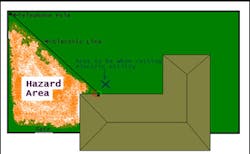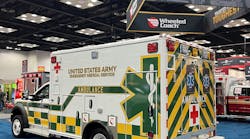Have you ever been in an attic operating a hoseline and hear that dreaded popping sound? It makes it very difficult to move after hearing that sound. Oh, how I hate electricity on the fireground.
There are three common methods of shutting off electricity. The quickest and least damaging is to shut off all the breakers. The problem with this method is that the breakers can be difficult to locate and sometimes it just does not work. Breaker panel boxes can be located inside or outside of a structure. They can be located in almost any room in a house. They can be hidden behind pictures, furniture or clothes.
Turning off breakers is the method preferred by most departments. According to Firefighter Dave Haenelt of the Englewood, NJ, Fire Department, this is the only method they use. They try to find the main breaker switch and turn it off. If there is not one, they take note of any tripped breakers and shut off the rest. If the breakers cannot be found or if shutting them off is unsuccessful, they wait for the electric company.
Pulling the meter is another option. Some departments have strict rules against this; others do not. If your department allows this maneuver, you need to have a certain amount of knowledge before carrying out this assignment. Meters usually have a ring around the glass cover with some type of locking mechanism on it. A pair of wire cutters will usually cut through this wire-type lock. You have to raise the metal cover and then give the meter a strong push up and then down by the glass cover to remove the meter.
The glass cover, along with parts inside the cover, acts like a large breaker (see photo 2). When the meter is removed, the flow of electricity is disrupted to the entire structure. This is a maneuver that must be performed in full bunker gear, with special attention paid to gloves and eye protection. Removing a meter has been known to cause a large, single spark. Use extreme precaution. Some newer meters come with a locking mechanism on the ring that requires a special key to unlock them (see photos 3 and 4). If you encounter any of these meters, contact your local electric company. They are generally very willing to help the fire service with training and providing any equipment that is needed.
The last method of disconnecting the electricity is to cut the loops (see photo 5). This is accomplished by using a "hot stick" and lineman gloves (see photos 6 and 7). This method should only be performed on residential units. Cutting electricity to any type of apartment complex or commercial structure should be left to the electric company as the amount of electricity flowing to these types of buildings is radically more than what flows to a residential structure. This additional electricity can easily damage your equipment and yourself. The most important thing to remember when you are dealing with electricity in a commercial structure is to call the electric company early.
There is one rule for cutting electricity - always work with a partner. Due to the obvious dangers involved in cutting electricity, you want a partner there to not only assist you, but also to call for help in the case of an emergency. Having a partner provides an extra set of eyes to watch for hazards and to provide some lighting if it is dark. The fact that the power lines could already be down on the ground at nighttime is another reason to always work with a partner.
There are multiple hazards that must be considered when cutting loops on a residential structure. First is the location of the weather-head. If the weather-head is located in the backyard of a structure, your two concerns should be whether or not the power line has fallen onto the fence or ground, and Buttercup, the family's sweet and lovable pit bull that would just love to play chew the bone with your leg. (This is another reason to always carry hand tools.)
Once you have located the weather-head and entered the backyard safely, if necessary, you need to consider where you are going to position yourself. This has everything to do with the angle of the power lines from the power pole. You want to position yourself on the side with the greatest angle (see photo 8). With this positioning, if the line were to break free unexpectedly, you would be out of the way and not in danger of having the line drop on top of you.
When you are cutting loops, you will encounter three separate lines. Two will be solid black; the third will be silver and black or plain silver. This third line is the ground wire and should not be cut.
This will be the only thing that holds the power lines up once the two loops have been cut. There are two schools of thought on how to cut loops. One is to cut each loop once, staggering the cuts. The other is to cut a small piece out of each loop. I prefer the second method. Although it takes a little more time, you do not have to worry about the cut ends of a particular wire coming back into contact with each other.
How do we train on cutting electrical utilities? The easiest way is to pay attention whenever you go into a residence. Without browsing through the entire house, try to notice as you walk in and out of a house where the breaker box is located. See if there are any common places they are found. Of course, these breaker boxes can be located in any room or even be located on the outside of a house. Notice the location of meters and electrical loops. When it comes to using the hot stick, just playing with it breeds familiarity. If you have any burnt up structures, with the owner's permission, practice on their electrical loops (if they have not already been repaired by the electrical company). Make sure to cut as small a section as possible off the wire to keep further damage to a minimum and allow for others to practice. Even cutting small branches out in the station's yard can give you the same feel for cutting wires, without the damage and risk. This last idea may sound silly, but actually works just fine.
The number one thing to remember about electricity is to have a healthy respect for it. Use caution at all times. This means being fully bunked out with your helmet, eyewear and proper glove protection in place. Have a partner watch out for you, use the proper equipment and take your time and you will insure a successful operation.
The last note on this procedure is to voice over the radio to command that the power has been cut. This works three fold: it lets command know that one more item on the to-do list is complete; it lets everyone on scene know the power has been cut; and it will allow on-scene personnel to communicate with you if the power is still hot so you can take further measures. Trust me, if the electricity is not shut off and you are telling everyone that it is, they will enthusiastically let you know otherwise.
There are a number of props that can be made with real weather-heads on which your station can practice. I have chosen not to make any due to the fact that we have access to a house that is completely burnt out and has been vacant for the past three years. This house has served as our "training house" for some time. With a little creativity, I am sure that you could come up with any number of props for cutting electrical loops and pulling meters.
Please send any ideas for future training drills, or suggested improvements and variations on this drill, to my e-mail. You and your department will receive credit for any ideas used in future articles.
Related Links:- Detailed Schematic of photo 8 (PDF)
- Company Level Training - Utility Control Part 1
- Company Level Training - An Introduction & links to all Company Level Training articles
- Webcast:Company Level Training by Larry Manasco
Larry Manasco has been with the Fort Worth, TX, Fire Department for 13 years and has served as a lieutenant for the past four years. He holds the classification of Fire Officer I and Hazardous Materials Technician. He currently works in one of the busiest engine companies in Fort Worth. He has worked for Firehouse World in San Diego where he was an assistant instructor for FDNY Battalion Chief Salka's "Get Out Alive" H.O.T. class. Lt. Manasco will be teaching two separate classroom sessions in San Diego at Firehouse World 2008 on "Company Level Training". Click here to view Larry's recent webcast: Company Level Training. You can contact Larry by e-mail at [email protected].






